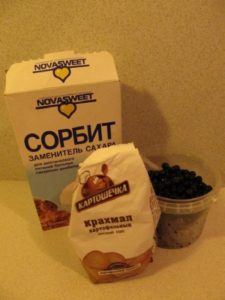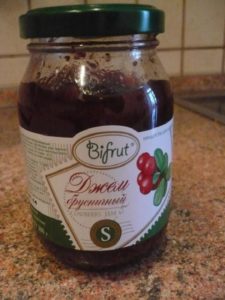Content
- 1 What is sorbitol and what does it look like
- 2 Where is sorbitol contained
- 3 Calorie content and glycemic index of sorbitol
- 4 Useful properties of sorbitol
- 5 Sorbitol for weight loss
- 6 Sorbitol for diabetes
- 7 Is sorbitol possible for pregnant and lactating women
- 8 The benefits and harms of sorbitol for children
- 9 Sorbitol use
- 10 Daily intake
- 11 How to take sorbitol medicinally
- 12 Sorbitol in cooking
- 13 The harm of sorbitol and contraindications to use
- 14 Which is better: sorbitol or xylitol
- 15 Which is healthier: sorbitol or fructose
- 16 Conclusion
- 17 Reviews
The modern life rhythm with constant stress provokes people to eat sweets every day. This is easy to explain: sugar stimulates a good mood, has a calming effect on the body. But at the same time, everywhere they talk about its dangers and advise to replace it with analogues. Sorbitol is the most popular sweetener. This article will explore the benefits and harms of sorbitol.

What is sorbitol and what does it look like
Sorbitol is a substance that is also called glucin, a six-alcohol alcohol with a sweetish taste. Sorbitol is registered as a food additive E420, the benefits of which are a matter of controversy. Glucine looks like a white, solid, crystalline substance, odorless, with a pleasant taste, well soluble in water. The sweetness of the sweetener sorbitol is about 2 times lower than that of sugar.

Thanks to these qualities, baked goods and other dishes with a sweetener during heat treatment retain a sweet taste and benefit.
Where is sorbitol contained
In its natural state, a sweetener is an organic compound. Glucine is found naturally in many fruits, berries and plants that are rich in beneficial properties. In industry, glucine is made from corn starch.

Calorie content and glycemic index of sorbitol
It should be understood that sorbitol is not beneficial for weight loss. The calorie content of glucin is lower than sugar and per 100 g is about 290 kcal, so the harm and benefits of the sweetener sorbitol are controversial. To make a dish or drink sweet, a substitute will have to be added no less than sugar, which does not at all contribute to an increase in beneficial properties. However, the sweetener E420 has a low glycemic index, so it does not increase blood glucose, this quality will benefit diabetics.
Glucine has a glycemic index of 9 units, sugar has about 70. This quality allows the use of a sweetener for the manufacture of chocolate, cookies, sweets for persons with diabetes. Such foods will not harm diabetes.
Useful properties of sorbitol
Useful properties of the substitute:
- the substance is completely absorbed during digestion;
- has a useful property to reduce the consumption of B vitamins;
- benefits due to its high nutritional capacity;
- has laxative properties.
Its regular inclusion in the diet helps to improve the functioning of the intestines, since the microflora is normalized, and the organ is regularly cleansed. This beneficial property is invaluable in diabetes.

It is allowed to use sorbitol instead of sugar during pregnancy, but cleaning during this period cannot be carried out, otherwise there will be harm, not benefit.
Glucine can increase their effects and, as a result, harm the body. Sweetener helps cleanse, but use with care
Sorbitol will benefit the liver as it is a choleretic agent.
The benefits and harms of sorbitol sweetener are also used for such gastrointestinal pathologies:
- cholecystitis;
- colitis;
- hypovolemia.
It is also useful for diseases of the genitourinary system:
- with a solution of glucin, the bladder is washed;
- use a dissolved sweetener for acute renal failure and after surgery.
Sorbitol for weight loss
Sugar substitutes are divided into 2 groups:
- Synthetic.
- Natural.
Glucine is a natural sugar analog. The first time it was found in the fruits of mountain ash. Subsequent studies have revealed its presence in apples, gooseberries, algae, apricots and some plants.
For weight loss, the benefits of a sweetener have been used not so long ago. But its ability to burn fat is a myth. The substance is used for weight loss due to its other beneficial properties. The sweetener contains fewer calories than sugar, but it is not as sweet. Therefore, there will be no benefit from using sorbitol instead of sugar.
Sorbitol for diabetes
Often in diabetes, sugar is replaced with beneficial glucin. This substance does not alter blood glucose levels. However, despite this useful property, doctors do not recommend overusing the substitute. It is allowed to use the sweetener for 4 months, no more. Then it is necessary to exclude it from the diet for a short period. Benefit is possible only if taken correctly.
Is sorbitol possible for pregnant and lactating women
The use of a sweetener can cause bloating, diarrhea, weakness, so it is better for pregnant or lactating women not to use this substance. It is advisable to give preference to natural products.

If a woman's health does not allow her to consume sugar, then it can be replaced with sorbitol. However, it should not be abused, as it can harm the expectant mother.
The benefits and harms of sorbitol for children
The use of glucin for children under 12 years of age is not recommended. A child of this age must receive sugar for normal development. In children, it is well absorbed and consumed completely for energy. However, if the child has diabetes, then experts recommend replacing sugar with sorbitol. Since this analogue has the most optimal composition in comparison with other sweeteners.

When using a sweetener in older people, it is important to approach the situation individually, this is how you can get benefits, not harm, from this sugar substitute. In old age, people are often tormented by constipation, it is for such cases that the beneficial properties of glucin will be very relevant.
Sorbitol use
The beneficial properties of the sweetener allow it to be used as an analogue of sugar in the production of dietary products: drinks, chewing gum, sorbitol cookies and other goods that are beneficial for diabetics. Due to its ability to draw moisture from the surrounding space, glucine helps to slow down the aging process and change the physical state.
In pharmaceutical products, sorbitol is used as a structure-forming substance - a filler in the production of gelatin capsules, vitamins, creams, ointments, pastes, and cough syrups. It is used in the production of ascorbic acid.In addition, the sweetener is used as a hygroscopic drug in cosmetic products (production of creams, tooth paste, masks, powders, etc.).
Daily intake
An overdose of a substitute threatens to harm the digestive system: it contributes to flatulence, diarrhea, vomiting, weakness, pain in the abdominal cavity. Dizziness often occurs. The sugar substitute is not advised to be included in the diet every day; the daily dose should not be more than 30-40 g for an adult.
How to take sorbitol medicinally
The sugar substitute is used as a means that removes toxins. The following methods will be useful:
- A solution with mineral water without gas 10 minutes before meals. Should be taken no more than 1-2 months;
- Intravenous injection using droppers for 10 days;
- For weight loss, take 20-40 g of sorbitol per day as an alternative to sugar.
To cleanse the intestines
A one-time intake of 40-50 g of sweetener helps to induce bowel movements, cleanse the intestines. The procedure is quick and painless. This method is safe and effective for constipation that is triggered by gastritis, colitis, or nervous shock. It is not recommended to use sorbitol as a laxative all the time.
For tubage at home
Tubage with sorbitol and mineral water helps prevent bile stagnation and enhances immunity. The procedure with the addition of rose hips helps to normalize blood pressure and cleanse the body of toxins.

First, it is recommended to prepare an infusion for cleansing:
- 50-70 g of rose hips are poured into a thermos and poured with 2 glasses of boiling water.
- Leave the mixture to infuse overnight.
- In the morning, filter the broth and pour 20-30 g of glucin into 200 ml of the drink. After the infusion is thoroughly mixed and drunk on an empty stomach.
- After half an hour, they finish drinking the drink that remained in the thermos, without sweetener.
- After that, you should empty the intestines.
The course of therapy consists of six procedures. Purification should be carried out every 2-3 days.

For probing
Blind probing with sorbitol is a method of flushing the gallbladder, intestines and liver. The beneficial properties of this method appear because the sweetener acts as an absorbent. For better absorption, a hot sea salt bath is recommended.
To cleanse the intestines, you need a heating pad, boiled water and sorbitol:
- Dissolve 20-30 g of sugar substitute in half a glass of boiling water and stir thoroughly. Next, the resulting solution must be drunk slowly, not allowing it to cool.
- After you need to lie down. It is not allowed to sit or walk, as this will worsen the outflow of bile, in which case the procedure will be harmful.
- It is advisable to apply a heating pad to the right side, in the area of the hypochondrium, where the liver is located.
- Then you should wait 2 hours. There should be a desire to empty the bowels. At this moment, harmful substances will be removed from the body with waste products.
- If the patient feels weak, then at night it is necessary to drink tea with sorbitol.
- As a rule, the next morning a person experiences a surge of energy and an increase in tone.
Sorbitol in cooking
Due to the useful properties of the substitute, it is recommended for use in cooking. The benefits and harms of the supplement cannot be compared with substitutes with similar effects.
Sorbitol sweets
Sorbitol is often used in the manufacture of sweets and confectionery products for people with diabetes. These products can be found in many stores.

Among the most popular:
- sorbitol cookies;
- sorbitol-based sweets, their benefits for diabetics are obvious;
- sugar-free chewing gum;
- diet drinks;
- chocolate.
Such products are presented in the public domain, in order to make sure that it is sorbitol in the composition, and not other substitutes, the composition should be studied.
Sorbitol jam
Jam with added sugar substitute is in demand among people with diabetes, it is beneficial and does not harm the body.

Since sugar and its analogs differ in sweetness, 1 kg of fruit will require:
- for making jam - 1.5 kg of sorbitol;
- for jam - 700 g;
- for jam - 120 g.
These norms can be adjusted depending on taste preferences. But in any case, it is recommended to take into account the sweetness of the fruits that serve as the main raw material.
To make jam from raspberries, strawberries, plums or black currants, you need to take 1.5 kg of sorbitol per 1 kg of berries. First, the fruits must be prepared: rinse and dry. After the berries are covered with sugar substitute and left for half a day at room temperature. It is necessary to cook the resulting mixture daily for about 15 minutes, and so continue for 3 days. The resulting mass should be poured into banks and rolled up.
The harm of sorbitol and contraindications to use
All of the beneficial properties of glucin do not reduce the harm from this substitute. The abuse of a sweetener can, instead of benefit, bring significant harm in the form of the following negative reactions of the body:
- nausea and vomiting;
- pain in the lower abdomen;
- tachycardia;
- all kinds of disruptions in the activity of the nervous system;
- rhinitis.
Contraindications to the use of a substitute:
- Irritable Bowel Syndrome.
- Allergy to sorbitol.
- Ascites.
- Cholelithiasis.
An overdose of glucin provokes disturbances in the gastrointestinal tract, flatulence, diarrhea, vomiting, weakness and abdominal pain.
Which is better: sorbitol or xylitol
Both substances have their own beneficial properties and can be harmful if used thoughtlessly. These sugar substitutes are natural, about the same calorie content. However, xylitol has a more pronounced sweet taste, so less of it is required, respectively, dishes with it will be lower in calories. In addition, xylitol has properties to stimulate the secretion of bile, normalize the process of defecation and remove water from the body. Knowing this information, each person will choose a substitute that suits his requirements.
Which is healthier: sorbitol or fructose
In this choice, it is better to prefer sorbitol. The fact is that fructose has qualities that can be harmful. It is certainly much sweeter than sugar, but it also has a high glycemic index of about 30. Therefore, it provokes surges in blood glucose. By settling in the liver, fructose causes fatty hepatosis. In addition, it is as high in calories as sugar, so the harm from it is much higher.
Conclusion
This article discusses the benefits and harms of sorbitol. From all that has been said, the conclusion is obvious - glucin is useful only in certain cases. For example, sorbitol is clearly beneficial for diabetics.Before using it, it is imperative to consult a specialist, otherwise, instead of useful properties, you can cause serious harm to health.

